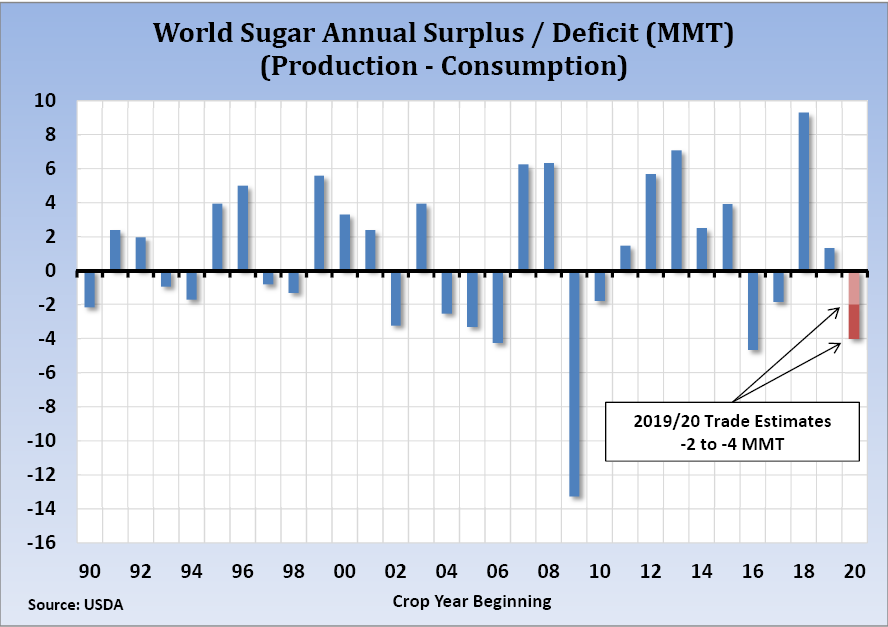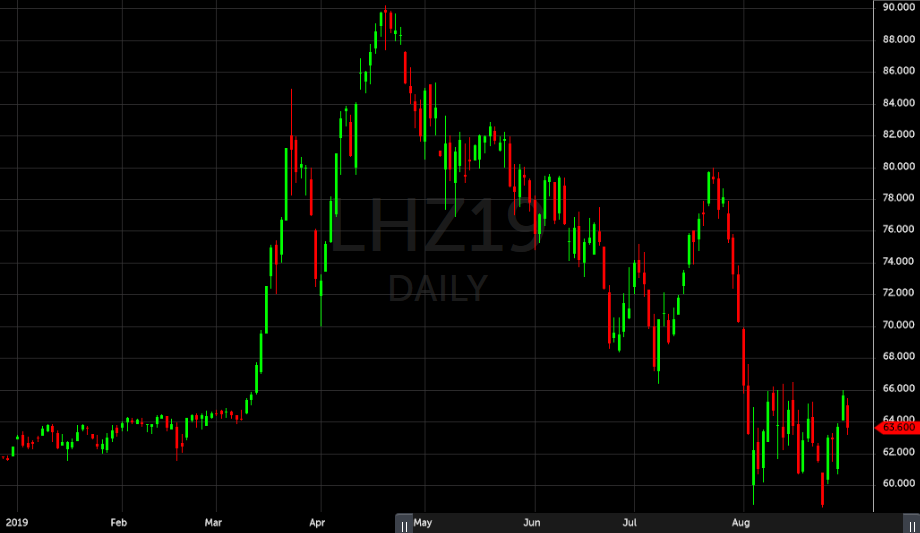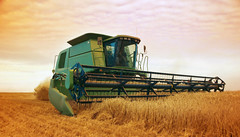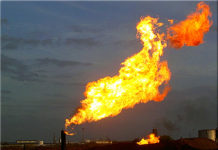Agriculture commodity prices have dropped substantially this year. The agriculture commodities consist mainly of the grains, livestock and softs (food). Some commodities like corn, lean hogs and cocoa had their moments in the sun this year. Now, most of the agriculture commodities are firmly entrenched in downtrends.
The good news is that I suspect many of these commodities could have a brighter future going forward and the prices are now at relatively low levels. Adverse weather and favorable trade negotiations with China open the opportunity for the markets to reverse from bearish to bullish.
Grain / Oilseed Complex
The corn, wheat and soybean markets have caused a great deal of stress for some traders this season. This has been an interesting year for these crops. The Midwest suffered from a very wet spring when farmers were planting crops – or trying to plant their crops. This created a situation where the crops, especially corn, were put in the ground later than normal. A late crop often leads to a smaller crop as quality suffers and not as much acreage gets planted. The biggest threat is an early freeze while the crops are not mature enough to handle the stress. That is a possible scenario on the minds of grain traders right now.
Since the crops were planted later in the season than normal, most farmers, analysts and traders expected substantially reduced acreage and yields this year for corn and soybeans. The USDA released their monthly crop estimates on August 12th, which lowered the numbers but they were far off market expectations. This caused a severe drop in grain prices.
ProFarmer conducts a crop tour every year to get an independent view of crop production and yields. They actually walk a sample of farms across the Midwest to inspect the quality and quantity of crops. Many traders didn’t believe the crop estimates from the USDA earlier in the month and they thought ProFarmer would have more realistic estimates. Their final results were released on August 23rd and they did lower estimates, but not by enough to have a big impact on prices.
Another issue of note is that China lost a large portion of their hog production this year due to the African swine flu. They often buy corn to feed their hogs, but there is obviously less demand since they have less hogs to feed. That is a negative for corn prices, along with the China trade war unless there are some positive developments.
Outlook for Grains
Grain prices are at relatively low levels. The trends are down and they will need some positive developments to cause the trends to turn higher.
Weather – An early freeze across the Midwest could do serious damage to already struggling corn and soybean crops. However, there is nothing significant currently in the weather forecasts. Without an early freeze, the crops will probably come in somewhere in the middle of the ProFramer and USDA estimates. This is probably what the markets have factored into prices.
Trade Issues – The trade issues with China have been devastating to grain prices. The markets typically rely on China for major purchases and this has basically been shut down and the future remains uncertain. There was some good news on a trade deal with Japan, as they will apparently purchase our excess corn supplies.
Overall, corn and soybean prices tend to drift lower into harvest time in the fall if there are no major weather issues or increased demand. I don’t see prices going too much lower from here, but rallies might not go too far unless there is some good news on China trade or there is an early freeze in the Midwest.
Softs Complex
The softs complex of focus is: cocoa, sugar, coffee and cotton. Prices on these commodities have dropped sharply, but they could offer some significant gains from these prices.

Sugar – Brazil is the main focus when it comes to sugar production and usage for ethanol. China is often a pivotal player when it comes to demand. There is a forecasted supply deficit of about 4 million tons in the coming year, which is expected to be supportive for prices going forward. The price of gas is relatively low, which causes Brazil to produce less ethanol from sugar. That increases supplies for sugar, but China is expected to purchase more sugar this year since they are behind their normal pace. Overall, the prevailing trend is for production decreases from major producing countries worldwide and this sets up support for higher prices.
Cocoa – This market has been interesting recently as prices took a nosedive this summer on news that Ivory Coast will have a record crop this year of about 2.2 million tons. Cocoa is prone to wild swings in price and this was no exception. The good news is that prices dropped about 17 percent and other major producers like Ghana and Nigeria are having production issues. Demand has also been strong and this sets the market up for a production deficit this season. With the recent drop in prices and a good fundamental setup, the downside looks limited and prices could rise from here.
Cotton – Prices of cotton have reached multi-year lows around the 58 level. This has typically been solid support for cotton over the years and represents a value area for the market. This year’s crop is in good condition, but there is some stress in areas of Texas. Low prices and possibly improving trade issues with China are the main reasons for a turnaround in the market. There appears to be little downside left in this market, but a catalyst for higher prices has yet to emerge.
Coffee – Much like the rest of the commodities, the price of coffee has dropped and is down about 20 percent this year. Demand doesn’t appear to be great, while there are some questions with the quality of Brazil’s crop this year. Vietnam is having some weather issues that could lead to some production losses. Prices are relatively cheap, but it is hard to see the big picture reason for prices going higher other than they are so low right now.
Livestock Complex
Lean hogs and live cattle are the agriculture markets that could offer the most upside potential in the near future. These markets have been on a wild ride so far this year, as prices rallied strongly and then the air was sucked out of the markets and prices tumbled. Much of that is due to trade issues with China, but the market outlook could still be bright.
Cattle – The supply and demand numbers setup a good long-term picture for cattle prices moving higher. This was the case earlier in the year, then China trade issues came into play and prices dropped. The market was trying to bottom and then the hammer dropped on cattle with a fire at a Tyson meat processing facility in Kansas. This plant processes about 6 percent of the cattle supply, which is a significant amount. This basically caused a backlog of supply of cattle to be processed, which theoretically led to an overnight drop in demand for cattle and prices went into freefall.
The market is trying to regroup and those cattle will eventually find their way through the system. The fundamentals still look good for the market going forward, but the trade issues are still an overhang. The Japan trade deal looks to be beneficial to the markets. Cattle prices should eventually work their way higher.
Hogs – The long term picture looks good for pork, but the big wild card is China. Earlier this year, China announced a major outbreak of African Swine Flu. This basically led to the destruction of about 30 percent of their hog population and will dramatically lower their pork production going forward. China is the world’s largest pork producer at about 50 percent.

The lean hog market had a sharp rally earlier this year on the news, as China would likely turn to the US for pork. This was great for the market, but the China trade issues and tariffs came into play and prices sunk since a peak in April. The bigger picture is that China will probably have to turn to the US to feed their people and the Japan trade deal is beneficial too. Even if China doesn’t import directly from the US, they will import from other countries. This will increase world demand. Hog prices could have a lot of upside potential from here and could be one of the best performing commodities into next year.
Price Outlook for Agriculture Commodities
The main factor I see when analyzing the agriculture commodities is that most of the prices are very low. They look like good value, but I have traded commodities long enough to know that prices can always go lower than you expect. However, the downside risk appears to be much lower than the upside potential at these levels.
Some of these commodities could trade in a range for the near future or drift lower. A trade deal with China or at least a cooling off period should offer decent upside moves. There are also a number of factors that could create more favorable supply and demand situations.




